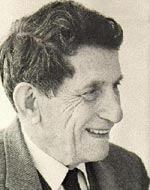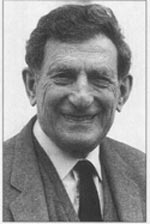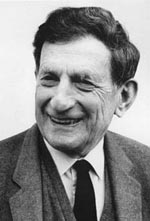
Shebang is grateful to F. David Peat, David Bohm’s biographer.
In 1950 David Bohm wrote what many physicists consider to be a model textbook on quantum mechanics. Ironically, he never accepted that theory of physics.
He went against the tide of modern physics for more than 30 years. Believing that the nature of things is not reducible to fragments or particles, he argued for a holistic view of the universe. He demanded that we learn to regard matter and life as a whole, coherent domain.
Bohm was always a highly respected theorist. Since his death approval for his ideas has increased.
One of Starlab’s young theorists told Shebang that his generation of physicists love Bohm ‘ because we're bloody sick and tired of quantum mechanics professors telling us that thinking about interpretations is for armchair philosophers. Meanwhile the so-called standard view doesn't make an ounce of sense to anyone with a brain size upwards from that of a goddamn pea!’
A demonstration
David Bohm: About the time I was looking into these questions, a BBC science program showed a device that illustrates these things very well.
It consists of two concentric glass cylinders. Between them is a viscous fluid, such as glycerine. If a drop of insoluble ink is placed in the glycerine and the outer cylinder is turned slowly, the drop of dye will be drawn out into a thread. Eventually the thread gets so diffused it cannot be seen. At that moment there seems to be no order present at all. Yet if you slowly turn the cylinder backward, the glycerine draws back into its original form, and suddenly the ink drop is visible again. The ink had been enfolded into the glycerine, and it was unfolded again by the reverse turning.
Suppose you put a drop of dye in the cylinder and turn it a few times, then put another drop in the same place and turn it. When you turn the cylinder back, wouldn't you get a kind of oscillation?
Yes, you would get a movement in and out. We could put in one drop of dye and turn it and then put in another drop of dye at a slightly different place, and so on. The first and second droplets are folded a different number of times. If we keep this up and then turn the cylinder backward, the drops continually appear and disappear. So it would look as if a particle were crossing the space, but in fact it's always the whole system that's involved.
We can discuss the movement of all matter in terms of this folding and unfolding…

The son of a furniture dealer, Bohm was born in Wilkes-Barre, Pennsylvania, in 1917. He studied physics at the University of California with J. Robert Oppenheimer. Unwilling to testify against his former teacher and other friends during the McCarthy hearings, Bohm left the United States and took a post at the University of São Paulo, Brazil. From there he moved to Israel, then England, where he eventually became professor of physics at Birkbeck College in London.
Bohm is perhaps best known for his early work on the interactions of electrons in metals. He showed that their individual, haphazard movement concealed a highly organized and cooperative behaviour called ‘plasma oscillation’.
This intimation of an order underlying apparent chaos was pivotal in Bohm's development.In 1959 Bohm, working with Yakir Ahronov, showed that a magnetic field might alter the behaviour of electrons without touching them.
During the Fifties and Sixties Bohm expanded his belief in the existence of hidden variables that control seemingly random quantum events. His ideas diverged more and more from the physics of the day, but are coming to be more highly regarded now.
In the Sixties Bohm met the Indian philosopher Jiddu Krishnamurti, and their continuing dialogues, published as a book, The Ending of Time, helped the physicist clarify his ideas about wholeness and order.
Even in moving through space, there is a movement of meaning. In a moving picture, with twenty-four frames per second, one frame follows another, moving from the eye through the optic nerve, into the brain. The experience of several frames together gives you the sense of flow.
In classical mechanics, movement or velocity is defined as the relation between the position now and the position a short time ago. What was a short time ago is gone, so you relate what is to what is not. This isn't a logical concept… you are relating different frames that are co-present in consciousness. You're relating what is to what is. A moment contains flow or movement. The moment may be long or short, as measured in time. In consciousness a moment is around a tenth of a second. Electronic moments are much shorter, but a moment of history might be a century.
At any given moment we feel the presence of all the past and also the anticipated future. It's all present and active. I could use the example of the cylinder again. Let's say we enfold one-droplet h times. Then we put another droplet in and enfold it N times. The relationship between the droplets remains the same no matter how thoroughly they are enfolded. So as you unfold, you will get back the original relationship. Imagine if we take four or five droplets--all highly enfolded--the relationship between them is still there in a very subtle way, even though it is not in space and not in time. But, of course, it can be transformed into space and time by turning the cylinder. The best metaphor might involve memory. We remember a great many events, which are all, present together. Their succession is in that momentary memory: We don't have to run through them all to reproduce that time succession. We already have the succession.
When you are talking to somebody, your whole intention to speak enfolds a large number of words. You don't choose them one by one. Any one word has behind it a whole range of meaning enfolded in thought.
Consciousness is unfolded in each individual. Clearly, it's shared between people as they look at one object and verify that it's the same. So any high level of consciousness is a social process.
The word, which is outside, evokes the meaning, which is inside each person.
Meaning is the bridge between consciousness and matter. Any given array of matter has for any particular mind a significance. The other side of this is the relationship in which meaning is immediately effective in matter. Suppose you see a shadow on a dark night. If it means "assailant," your adrenaline flows, your heart beats faster, blood pressure rises, and muscles tense. The body and all your thoughts are affected; everything about you has changed. If you see that it's only a shadow, there's an abrupt change again.
The word hormone means "messenger," that is, a substance carrying some meaning. Neurotransmitters carry meaning, and that meaning profoundly affects the immune system. This understanding could be the beginning of a different attitude to mind-and to life.
I say meaning is being! So any transformation of society must result in a profound change of meaning. Any change of meaning for the individual would change the whole because all individuals are so similar that it can be communicated.

A few years ago The New York Times noted that some physicists were critical of grand unification theory, saying that not much had been achieved. Defenders of grand unification theories said it would take about twenty years to see results.
It seems that people are ready to wait twenty years for results if you've got formulas. If there are no formulas, they don't want to consider it. Formulas are means of talking utter nonsense until you understand what they mean. Every page of formulas usually contains six or seven arbitrary assumptions that take weeks of hard study to penetrate.
At this point, I think that the major issue is mathematics. In super-symmetry theory an interesting piece of mathematics will attract attention, even without any experimental confirmation.
We have become a scientific society. This society has produced all sorts of discoveries and technology, but if it leads to destruction, either through war or through devastation of natural resources, then it will have been the least successful society that ever existed. We are now in danger of that.
Where we are going depends on the programs of four thousand five hundred million people, all [The interview was conducted in the 80’s] somewhat different, most of them opposed to one another. Every moment these programs are changing in detail. Who can say where they are going to lead us? All we can do is start a movement among those few people who are interested in changing the meaning.
If we don't establish these absolute boundaries between minds, then I think it's possible they could in some way unite as one mind. If there were a genuine understanding of and feeling for wholeness in this group mind, it might be enough to change things--though as the external circumstances gain momentum it becomes harder. This is important, especially if there is a catastrophe, so that the notion of group minds might remain in the consciousness of survivors.
Death must be connected with questions of time and identity. When you die, everything on which your identity depends is going. All things in your memory will go. Your whole definition of what you are will go. The whole sense of being separate from anything will go because that's part of your identity. Your whole sense of time must go. Is there anything that will exist beyond death? That is the question everybody has always asked. It doesn't make sense to say something goes on in time.
Anything I know about "me" is in the past. The present "me" is the unknown… But it projects itself as a whole series of moments. Ultimately, all moments are really one. Therefore now is eternity.
In one sense, everything, including me, is dying every moment into eternity and being born again, so all that will happen at death is that from a certain moment certain features will not be born again. But our whole thought process causes us to confront this with great fear in an attempt to preserve identity. One of my interests at this stage of life is looking at that fear.
[This last statement was made three years before he died]